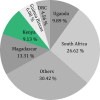Harnessing YouTube in advancing biodiversity conservation efforts and awareness across Africa
- PMID: 40525107
- PMCID: PMC12169165
- DOI: 10.7717/peerj.19545
Harnessing YouTube in advancing biodiversity conservation efforts and awareness across Africa
Abstract
YouTube (YT), an online video content application, has revolutionized the dissemination of information in various fields, including medicine, entertainment, and conservation science. Its potential in disseminating biodiversity conservation information has not been well assessed, especially in Africa, a biodiversity hotspot. When such assessments are conducted, they are usually species-specific, activity-based, or localized, making broader generalizations difficult. We evaluated the viewership and interaction of the videos posted about Africa across different organism groups, countries (geopolitical units), geographical regions, ecoregions, and channels (content creators). We assessed 431 videos, which collectively garnered 32,630,126 views, 364,700 likes, and 48,839 comments across 274 channels, five regions, and 31 African countries. The mean daily views varied significantly across countries, regions organism groups, and channels. Notably, more views per day were from biodiversity-rich countries, such as Madagascar, and most videos were posted from South Africa. Government and academic institutions posted fewer videos than individually owned and international biodiversity-related non-governmental organization (NGO) channels. Also, most channels posting about African biodiversity are based in the United States of America. Increased attention to biodiversity through social media engagement will likely stimulate external funding, international collaborations, policymaking, and participatory programs, benefiting both the public and organizations such as NGOs and governments. We observed a great need for increased participation by African-based content creators, primarily by government institutions, to effectively adopt a strong social media strategy to communicate information about biodiversity conservation, especially to the growing online population.
Keywords: Climate change; Invasive species; Social media platforms; Species extinction; Topical analysis.
©2025 Basooma et al.
Conflict of interest statement
The authors declare there are no competing interests.
Figures





Similar articles
-
A SIMBA CoMICs Initiative to Cocreating and Disseminating Evidence-Based, Peer-Reviewed Short Videos on Social Media: Mixed Methods Prospective Study.JMIR Med Educ. 2024 Oct 30;10:e52924. doi: 10.2196/52924. JMIR Med Educ. 2024. PMID: 39475500 Free PMC article.
-
Engagement With Web-Based Fitness Videos on YouTube and Instagram During the COVID-19 Pandemic: Longitudinal Study.JMIR Form Res. 2022 Mar 8;6(3):e25055. doi: 10.2196/25055. JMIR Form Res. 2022. PMID: 35258459 Free PMC article.
-
Video clips of the Mediterranean Diet on YouTube TM: A social Media Content Analysis.Am J Health Promot. 2023 Mar;37(3):366-374. doi: 10.1177/08901171221132113. Epub 2022 Oct 3. Am J Health Promot. 2023. PMID: 36191140 Free PMC article.
-
Analysis of public engagement with ten major global health topics on a social network profile and a newspaper website.J Glob Health. 2020 Jun;10(1):010902. doi: 10.7189/jogh.10.010902. J Glob Health. 2020. PMID: 32257171 Free PMC article. Review.
-
Dissemination of health content through social networks: YouTube and opioid use disorders.J Subst Use Addict Treat. 2024 Oct;165:209475. doi: 10.1016/j.josat.2024.209475. Epub 2024 Aug 5. J Subst Use Addict Treat. 2024. PMID: 39098570 Review.
References
-
- African Union African Convention on the Conservation of Nature and Natural Resources (Revised). Adopted at the 2nd Ordinary Session of the Assembly, Maputo, Mozambique, 11 July 2003. Entered into force 23 July 2016. 2003. https://au.int/sites/default/files/treaties/41550-treaty-Charter_Conserv... https://au.int/sites/default/files/treaties/41550-treaty-Charter_Conserv...
-
- Beall JM, Pharr LD, Von Furstenberg R, Barber A, Casola WR, Vaughn A, Peterson MN, Larson LR. The influence of YouTube videos on human tolerance of sharks. Animal Conservation. 2023;26:154–164. doi: 10.1111/acv.12808. - DOI
-
- Büscher B, Fletcher R. The conservation revolution: radical ideas for saving nature beyond the anthropocene. English edition. Verso Books; London: 2020. - DOI
MeSH terms
Associated data
LinkOut - more resources
Full Text Sources

